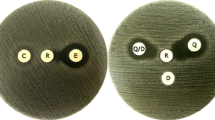Abstract
In vitro experiments were performed in which 6 to 12 strains ofStaphylococcus aureus, Streptococcus pyogenes, Haemophilus influenzae andEnterobacteriaceae were passaged nine times in sub-lethal concentrations of azithromycin or control antibiotics.Streptococcus pyogenes andStaphylococcus aureus quickly became resistant to rifampin as the MIC90 increased from 0.1 to > 50 µg/ml for both species. The MIC90 of azithromycin, erythromycin, amoxicillin and cefaclor increased by three dilutions forStaphylococcus aureus. The MIC values of azithromycin forStreptococcus pyogenes, Haemophilus influenzae andEnterobacteriaceae strains did not change significantly. However, forHaemophilus influenzae and theEnterobacteriaceae strains, the MIC values of erythromycin and oral cephalosporins increased four-fold. In the in vivo experiments, mice infected withStaphylococcus aureus orEscherichia coli contaminated sutures were administered azithromycin for three days, and on day 6 viable bacterial cells were recovered from the infection site. The sustained tissue concentrations of azithromycin indicated that the organisms would have been continuously exposed to azithromycin at the site of infection. Colonies isolated from azithromycin-treated and non-treated mice were cultured and their susceptibility to azithromycin compared. The azithromycin MIC values forStaphylococcus aureus cultures from treated and non-treated animals were identical. The azithromycin MICs forEscherichia coli recovered from treated animals were on average, less than one dilution higher than for control cultures. Emergence of significant resistance to azithromycin in the laboratory was not observed with the pathogens tested.
Similar content being viewed by others
References
Bright GM, Nagel AA, Bordner J, Desai KA, Dibrino JN, Nowakowska J, Vincent L, Watrous RM, Sciavolino FC, English AR, Retsema JA, Anderson MR, Brennan LA, Borovoy RJ, Cimochowski CR, Faiella JA, Girard AE, Girard D, Herbert C, Manousos M, Mason R: Synthesis, in vitro and in vivo activity of novel 9-deoxo-9a-aza-9a homoerythromycin A derivative; a new class of macrolide antibiotics, the azalides. Journal of Antibiotics 1988, 41: 1029–1047.
Retsema J, Girard A, Schelkly W, Manousos M, Anderson M, Bright G, Borovoy R, Brennan L, Mason R: Spectrum and mode of action of azithromycin (CP-62,993), a new 15-membered-ring macrolide with improved potency against gram-negative organisms. Antimicrobial Agents and Chemotherapy 1987, 31: 1939–1947.
Girard AE, Girard D, English AR, Gootz TD, Cimochowski CR, Faiella JA, Haskell SL, Retsema JA: Pharmacokinetic and in vivo studies with azithromycin (CP-62,993), a new macrolide with an extended half-life and excellent tissue distribution. Antimicrobial Agents and Chemotherapy 1987, 31: 1948–1954.
Dubnau D: Translational attenuation: the regulation of bacterial resistance to the macrolide-lincosamide-streptogramin B antibiotics. Critical Reviews in Biochemistry 1984, 16: 103–132.
Lai C-J, Dahlberg JE, Weisblum B: Structure of an inducible methylatable nucleotide sequence in 23S ribosomal ribonucleic acid from erythromycin-resistantStaphylococcus aureus. Biochemistry 1973, 12: 457–460.
Duval J: Evaluation and epidemiology of MLS resistance. Journal of Antimicrobial Chemotherapy 1985, 16, Supplement A: 137–149.
Goldman RC, Capobianco JO: Role of a energy-dependent efflux pump in plasmid pNE24-mediated resistance to 14- and 15-membered macrolides inStaphylococcus epidermidis. Antimicrobial Agents and Chemotherapy 1990, 34: 1973–1980.
Andremont A, Guy G, Courvalin P: Plasmid-mediated high-level resistance to erythromycin inEscherichia coli. Antimicrobial Agents and Chemotherapy 1986, 29: 515–518.
Andremont A, Sancho-Garnier H, Tancrede C: Epidemiology of intestinal colonization by members of the familyEnterobacteriaceae, highly resistant to erythromycin in a hematology-oncology unit. Antimicrobial Agents and Chemotherapy 1986, 29: 1104–1107.
Foulds G, Shepard RM, Johnson RB: The pharmacokinetics of azithromycin in human serum and tissues. Journal of Antimicrobial Chemotherapy 1990, 25, Supplement A: 73–82.
Atlas E, Turck M: Laboratories and clinical evaluation of rifampicin. American Journal of the Medical Sciences 1968, 256: 247–254.
McMurdoch J, Speirs CF, Wright N, Wallace ET: Rifampicin. The Lancet 1969: 1094.
Girard AE, Girard D, Retsema JA: Correlation of the extravascular pharmacokinetics of azithromycin with in-vivo efficacy in models of localized infection. Journal of Antimicrobial Chemotherapy 1990, 25, Supplement A: 61–71.
Author information
Authors and Affiliations
Rights and permissions
About this article
Cite this article
Retsema, J.A., Girard, A.E., Brennan, L.A. et al. Lack of emergence of significant resistance in vitro and in vivo to the new azalide antibiotic azithromycin. Eur. J. Clin. Microbiol. Infect. Dis. 10, 843–846 (1991). https://doi.org/10.1007/BF01975837
Issue Date:
DOI: https://doi.org/10.1007/BF01975837




